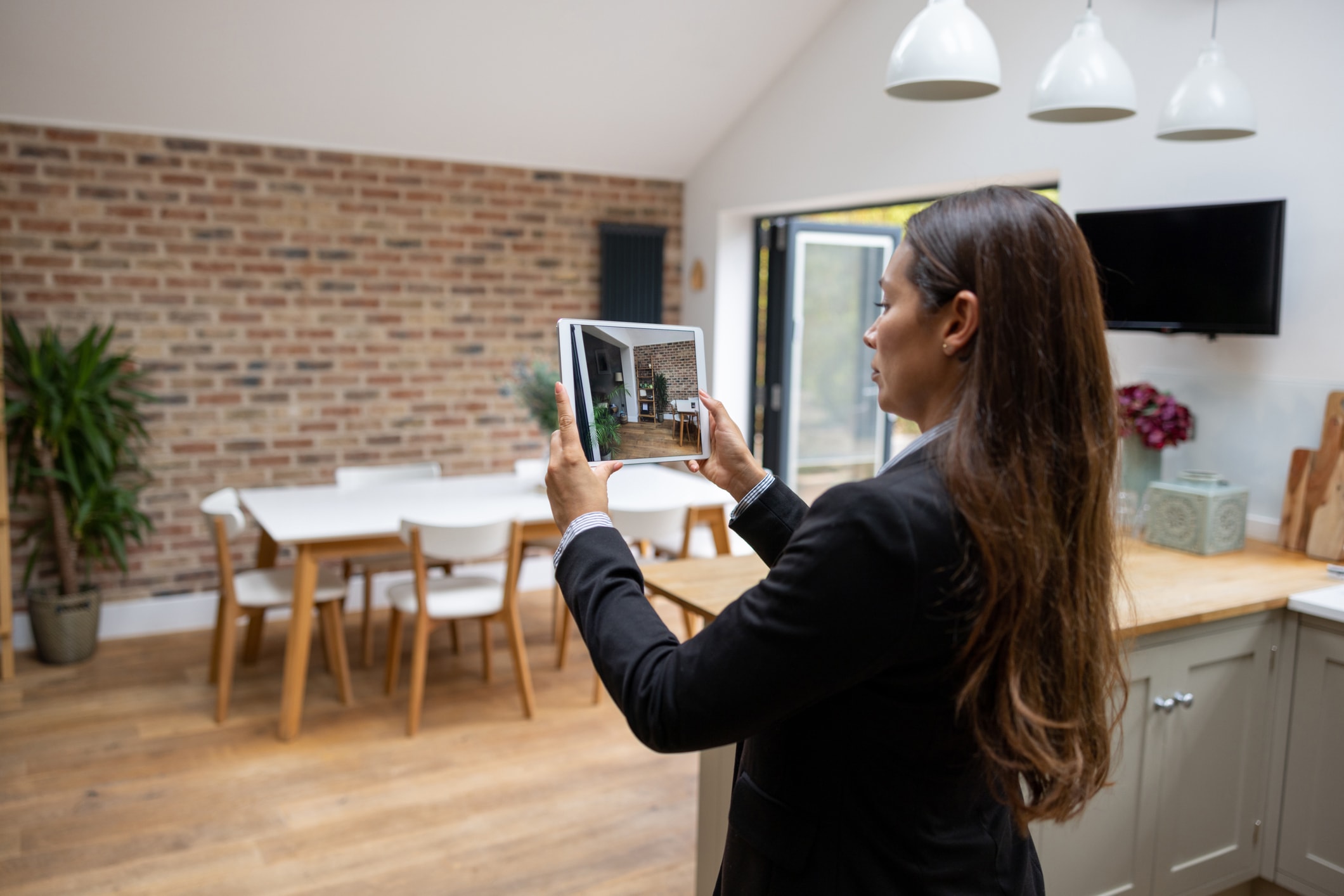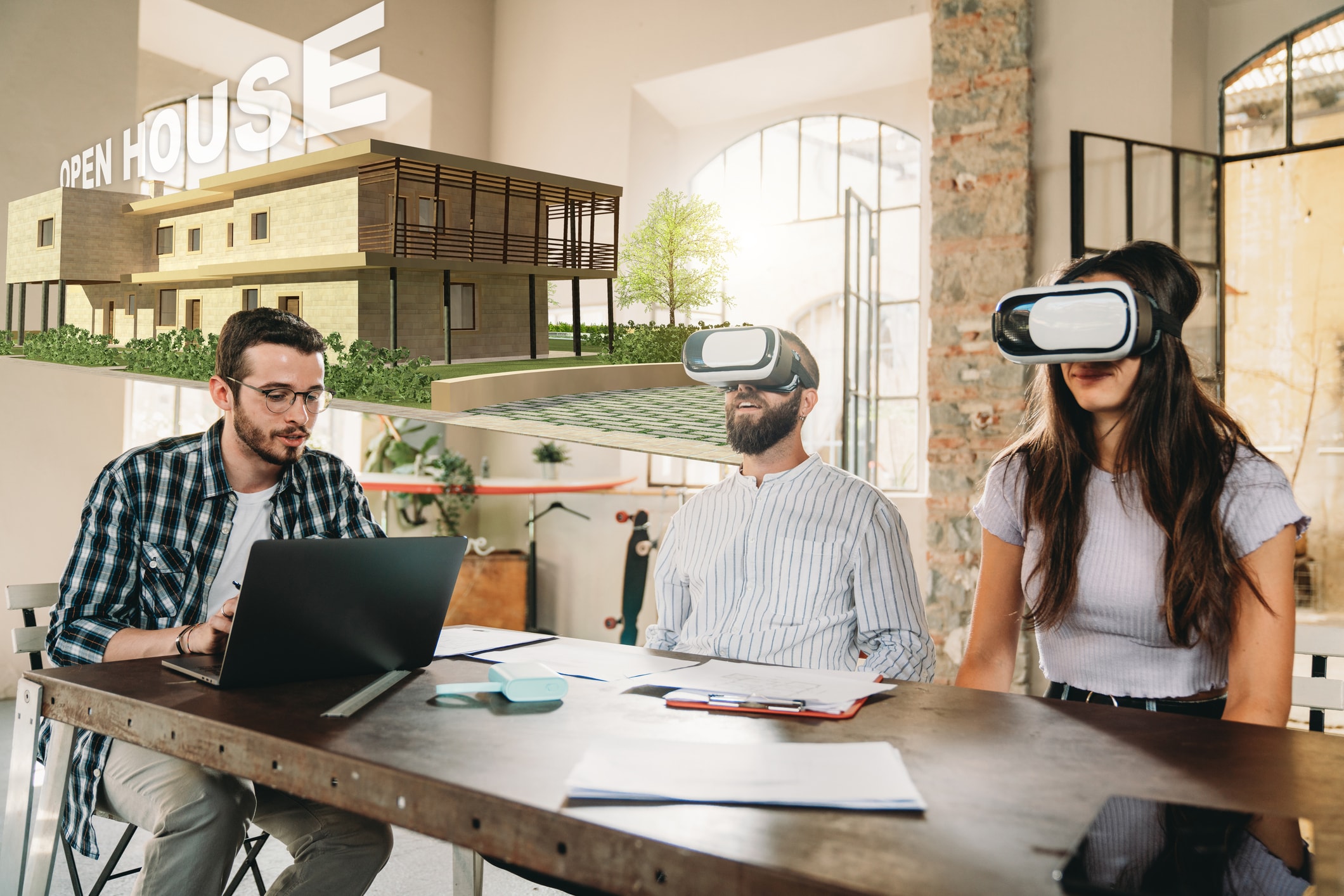Virtual reality (VR) is taking the real estate industry by storm, offering a game-changing way for real estate agents to showcase properties and engage with prospective buyers through VR in real estate. With the power of virtual reality technology, agents can create an immersive experience that allows potential buyers to explore a property as if they were physically there, regardless of their location.
This technology is becoming a vital tool in the real estate market. Real estate agents can attract potential buyers and clients in a way that traditional methods can't match. In a competitive market, offering virtual tours and augmented reality experiences can set agents apart, creating a more engaging customer experience that helps properties stand out.
Evolution of Virtual Reality in Real Estate
Early Adoption and Initial Use Cases
The early days of VR in real estate began with simple tours and 360-degree videos that gave users a basic sense of the space. Early adopters quickly recognised the value of virtual reality experiences in showcasing properties. This was especially useful for off-plan properties, where buyers needed to visualise a property that still needed to be built. Even then, the potential of VR in real estate was evident, with agents using it to bridge the gap between construction and sales.

Technological Advancements
As technology advanced, so did its applications in real estate. Today, VR offers high-resolution graphics, realistic environments, and interactive features that allow buyers to walk through properties, customise interiors, and even see how the space might look after renovations using virtual reality headsets. This immersive experience is made possible by sophisticated computer models and apps, which real estate agents use to provide a fully interactive exploration of properties.
VR platforms enhance technology, making it more accessible and practical for real estate applications.
For example, Start Beyond's EDGE 28 project used VR to create a completely immersive environment where potential buyers could explore every inch of the apartment as if they were there. This approach transformed the customer experience and created new opportunities for closing sales more quickly.
Key Applications of VR in Real Estate Marketing

Virtual Property Tours
Virtual tours are one of the most compelling applications of virtual reality headsets in real estate. They offer potential buyers the chance to explore properties from the comfort of their homes, saving time and money. This is particularly valuable for prospective buyers looking at properties in different cities or countries. Virtual reality platforms play a crucial role in these virtual property tours by providing the necessary software and environment for an immersive experience. By providing a free and accessible way to "visit" a site virtually, real estate agents can reach a wider audience and generate more interest in their listings.
Virtual Staging
Virtual staging has revolutionised how real estate agents present properties by offering virtual experiences. Instead of spending a significant budget on physical staging, agents can now use virtual reality to digitally furnish and decorate properties. This saves on costs and allows buyers to see the property in different styles and layouts, even with augmented reality enhancements.
VR headsets play a crucial role in virtual staging, providing an immersive experience that helps buyers better visualize themselves.
By offering a customised immersive experience, agents can help buyers better visualise themselves in the space.

Remote Property Showings
Virtual reality platforms also enable remote property showings, particularly useful for off-plan properties and international buyers. With VR, potential buyers can explore properties in detail anywhere in the world without physically visiting the site. VR experiences play a crucial role in these remote property showings, providing immersive and interactive tours that enhance the buyer's understanding of the property. This has opened up new opportunities in the real estate industry, allowing properties to be sold to buyers who may only step in after the purchase.

Interactive Showrooms
Interactive showrooms are another exciting development in real estate. These digital spaces allow clients to explore multiple properties within a single virtual environment. Using a VR headset, users can walk through different apartments, compare layouts, and make informed decisions without physically travelling from one location to another.
VR platforms play a crucial role in these interactive showrooms, providing the necessary infrastructure for immersive experiences.
This is a powerful tool for large-scale developments, where offering a comprehensive immersive overview of available units can be a significant selling point.

Benefits of VR for Real Estate Agents
Enhanced Client Engagement
VR significantly enhances client engagement by offering profoundly immersive VR experiences. Real estate agents who use VR have reported increased interest and faster decision-making from potential buyers, as the technology allows them to truly connect with the property. Virtual tours enhance client engagement by providing an interactive and detailed view of the property. This engagement is vital in converting interest into sales, especially in a competitive market where standing out is essential.
Increased Efficiency and Cost Savings
The costs of traditional staging, multiple showings, and international client visits can add up quickly. VR Platforms offer a solution by reducing these expenses while providing a high-quality customer experience.
Virtual reality headsets are crucial in increasing efficiency and cost savings by allowing potential buyers to experience properties remotely.
Real estate agents can use VR to filter out uninterested parties, allowing only serious buyers to engage further, thus making the process more efficient and cost-effective.

Differentiation in a Competitive Market
Differentiating your services with virtual reality experiences is crucial. By adopting VR technology, real estate agents can position themselves as forward-thinking and innovative, appealing to tech-savvy buyers. VR tours can play a significant role in differentiating services. This can make all the difference when attracting new clients or winning listings in a competitive environment.

Challenges and Considerations
Initial Investment and Learning Curve
While VR's benefits are substantial, there are challenges to consider, such as the initial investment in headsets, devices, and software and the learning curve for both agents and users.
Platforms also play a significant role in the initial investment, providing the necessary infrastructure for immersive experiences.
However, starting with basic setups and gradually expanding can help manage these challenges, and VR's power to transform the real estate process makes it worth the investment.
Technology Limitations
Despite its many advantages, VR technology, including virtual reality headsets, has limitations. Issues such as internet bandwidth, user discomfort with headsets, and needing high-performance computers can pose challenges.
Virtual reality platforms also play a significant role in these technology limitations, affecting the overall user experience.
However, as technology evolves, these barriers will likely diminish, making VR more accessible and user-friendly across the industry.
Case Studies and Real-World Examples
Successful VR Implementations
The success of VR in the real estate industry is well-documented, mainly through virtual reality experiences. Projects like Start Beyond's EDGE 28 demonstrate how virtual reality can directly contribute to sales by offering a fully immersive and interactive customer experience.
Virtual reality tours have played a significant role in successful implementations, allowing potential buyers to explore properties remotely.
Another example is a luxury property in Sydney that was sold to an international buyer who only experienced the property through VR, highlighting the technology's ability to close deals remotely.
Agent Testimonials
Real estate agents who have implemented VR experiences report significant benefits. They've seen faster sales cycles, more engaged clients, and a noticeable increase in potential buyers' interest. Virtual reality tours are crucial in agent testimonials, highlighting how this technology enhances client engagement and satisfaction. Virtual reality technology allows them to showcase properties in a way that traditional methods cannot, helping them to stand out and succeed in a highly competitive market.
Future Trends in Virtual Reality Real Estate
Emerging Technologies and Integrations
The future of virtual reality real estate looks bright, with emerging technologies like virtual reality platforms, augmented reality, and AI expected to further enhance the immersive experiences offered by VR. These technologies will enable even more detailed and interactive virtual tours, allowing buyers to explore properties in increasingly life-like and engaging ways. Virtual reality headsets are crucial in these emerging technologies, providing users an unparalleled immersive experience.
As these tools become more widely adopted, real estate agents who leverage them will be well-positioned to lead the industry.
Impact of VR on the Real Estate Industry
As VR technology evolves, its impact on the real estate industry through virtual reality experiences will only grow. From reducing the need for physical showings to expanding the reach of property marketing, VR is poised to transform how real estate agents do business.
Virtual reality tours play a significant role in this transformation, offering immersive ways for potential buyers to explore properties remotely.
Agents who want to thrive in the future of real estate must stay ahead of these trends and embrace virtual reality.
Conclusion
Summary of Benefits and Future Outlook
Virtual reality real estate is not just a buzzword—it's a transformative force reshaping the industry. By providing immersive experiences, reducing costs, and enhancing client engagement, VR offers many benefits for real estate agents and buyers alike. As technology advances, the role of VR in real estate is set to expand, making it an essential tool for anyone looking to stay ahead in this fast-paced market.
Call to Action
For real estate agents looking to differentiate themselves and improve their marketing strategies, it is time to embrace virtual reality technology. Whether you're interested in virtual tours, interactive showrooms, or remote property showings, VR offers endless possibilities to enhance the customer experience and drive sales. Start exploring VR solutions today and take the first step towards transforming your real estate business for the future.
FAQs: Virtual Reality in Real Estate
What is Virtual Reality (VR) in real estate, and how does it work?
VR in real estate uses advanced technology, including virtual reality headsets, to create immersive 3D environments that allow potential buyers to explore properties remotely. By wearing a VR headset or using a compatible device, users can virtually "walk through" a property, examine details, and experience the space as if they were physically present. Virtual reality platforms play a crucial role in how VR works by providing the software and infrastructure needed for these immersive experiences. This technology offers a realistic and interactive way to view homes, making it easier to visualise living on the property without needing to be in person.
How does VR benefit agents and their clients?
Virtual reality experiences offer several benefits for agents and their clients. It enhances marketing strategies for agents by providing innovative ways to showcase properties, attracting tech-savvy buyers, and reducing the need for physical site visits.
Virtual reality tours play a crucial role in these benefits by allowing potential buyers to immerse themselves in the property as if they were physically there.
For clients, VR offers convenience, allowing them to explore multiple properties from the comfort of their homes. It also helps international buyers or those with busy schedules to view properties remotely, saving time and money.
Is VR expensive for real estate agencies to implement?
While there is an initial investment in headsets and software, the long-term benefits often outweigh the costs. Basic VR setups are becoming more affordable, and the potential cost savings—such as reduced staging expenses and fewer in-person visits—can make VR a cost-effective solution.
Additionally, virtual reality platforms play a significant role in cost considerations, offering various pricing models and features that can impact the overall investment.
Agencies can start with more straightforward VR tools and gradually scale up as they see returns on investment.
Can VR replace traditional property viewings and open houses?
While VR offers highly immersive virtual reality experiences and a convenient way to view properties, it is generally seen as a complement to, rather than a replacement for, traditional property viewings. VR is handy for initial property exploration, allowing buyers to narrow their choices before visiting in person.
Virtual reality tours play a significant role in this discussion, providing an innovative way for potential buyers to explore properties remotely.
However, many buyers still prefer to physically visit a property before deciding.
What are the potential challenges of using VR in real estate?
Some challenges of using VR in real estate include the initial cost of virtual reality headsets, the learning curve for agents and clients, and potential technological limitations such as hardware requirements and internet bandwidth. Additionally, some users may experience discomfort with VR headsets, like motion sickness.
Virtual reality platforms also play a significant role in these challenges, as they require robust infrastructure and user-friendly interfaces to be effective.
However, as technology advances, these challenges are becoming more manageable, with improved hardware and software making VR more accessible and user-friendly.
